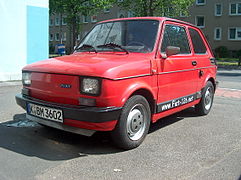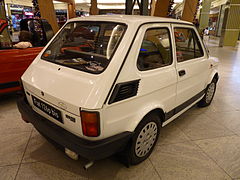Fiat 126
| Fiat | |
|---|---|
|
Fiat 126 (1972-1977)
|
|
| 126 | |
| Production period: | 1972–1987 Poland : 1973–2000 (as Polski Fiat 126p ) Austria : 1973–1975 ( Steyr-Puch ) |
| Class : | Microcar |
| Body versions : | Limousine , cabriolet |
| Engines: |
Otto engines : 0.6–0.7 l (17–19 kW) |
| Length: | 3054-3104 mm |
| Width: | 1374-1378 mm |
| Height: | 1302-1346 mm |
| Wheelbase : | 1840 mm |
| Empty weight : | 580-619 kg |
| Previous model | Fiat Nuova 500 |
| successor |
Fiat 126 TO Fiat Cinquecento |
The Fiat 126 was a small car from the Italian automobile manufacturer Fiat , which was built from summer 1972 to autumn 2000, most recently exclusively in Poland at FSM as Polski Fiat 126p . Its compact design makes it very manoeuvrable and still offers a relatively large amount of interior space. Italian and Polish designers and engineers created the shape of the car together.
Production in Italy and sales in Germany
As the successor to the Fiat Nuova 500 , the Fiat 126 was equipped with the air-cooled two-cylinder petrol engine with 594.5 cm³ displacement of the Fiat 500 R. The body was lengthened and reinforced while maintaining the same wheelbase. The tank was now installed on the right under the back seat instead of in the front trunk. The engine remained unchanged in the rear and achieved an output of 17 kW (23 hp) at 4800 rpm. The engine was also used in the sporty version 595 Abarth. The four-speed gearbox had an unsynchronized first gear, the top three gears were synchronized. The chassis with double wishbones at the front (the transverse leaf spring served as the lower wishbone and stabilizer) and oblique arms with coil springs at the rear was taken over from the 500. The wheel size was 12 inches. There were hydraulically operated drum brakes at the front and rear . The worm steering worked via a three-part tie rod on the front wheels.
From the summer of 1987 there was the Fiat 126 BIS with a water-cooled engine, which, like the Fiat 500 Giardiniera, was installed horizontally. The horizontal installation made it possible to create an additional trunk over the engine. This engine with 19 kW (26 PS) at 4500 rpm and 704 cm³ displacement (bore 80 mm, stroke 70 mm) was only available until the end of 1991, as the Fiat 126 BIS was difficult to sell due to the poor exhaust gas values . The water-cooled engine also turned out to be not very stable, it tended to overheat, resulting in defective cylinder head gaskets . The maintenance of the engine was difficult due to the installation position and the narrow engine compartment; the larger number of parts also made it more complicated to manufacture. Finally the production of the Fiat 126 BIS was stopped at the end of 1991.
In the Federal Republic of Germany, converted Fiat 126s were offered under the name "Figo" ("Fiat / Goggo"), which were equipped by Steinwinter in Stuttgart with engines from the Goggomobil (10 kW / 13.6 PS, 250 cm³, air-cooled 2- Cylinder two-stroke engine ). In the FRG this offer was aimed at holders of the old class IV driving license who were allowed to drive vehicles up to 250 cm³. This gave them the opportunity to drive a more modern small car.
In the Federal Republic of Germany, the Fiat 126 was marketed as "Bambino" from the late 1970s. The name "Bambino" was chosen as part of a competition by Fiat Germany. The "Bambino", which was sold in Italy as "Personal 4", differs from the previous version mainly through the engine of the type 126 A1.048 instead of the engine type 126 A1.000. The cylinder head of the engine for the German market is square instead of round. The spark plugs of the "Bambino" are in sleeves and not screwed directly into the cylinder head. The sleeves should prevent toxic exhaust gases from entering the interior with the heating air if the spark plug is leaking . You can recognize the "Bambino" by the rubber protective strips on the side and the plastic bumpers, which were also installed in the "Personal 4" version. The standard version kept the metal bumpers until the facelift in spring 1984.
The Fiat 126 was also offered as special models "Red", "Brown", "Black" and "Silver" around 1980, the latter being very rare. In contrast to the normal vehicles, these special models had green-tinted glazing and two reversing lights integrated into the rear lights . The rear lights differed significantly from the flat lights of the other versions. Some of these special models had gray instead of black bumper strips and bars. Reversing lights were only introduced in the series vehicles with the facelift in 1984, here in the rear bumper there is a reversing light on the right and a rear fog light on the left .
At the end of 1991, production of the successor Fiat Cinquecento began, which was supposed to replace the 126. Its production was not stopped until September 22, 2000. In 1994 there was a facelift for this model, it was called "Fiat 126 elx"; except for modified bumpers and doors, he got a G- Kat ex works . This was enough for classification according to the Euro 1 standard, which can lead to problems if you want to register a newer model in Germany from around 1992. Since some of the newer models built in Poland do not meet the guidelines applicable in Germany, it is possible that the vehicle cannot be registered in Germany.
In the meantime around 3,500,000 pieces have been produced.
The Fiat 126 is one of the cheapest insurable cars in Germany today. All Fiat 126 models are in the lowest type class 10 in all three types of insurance (liability, partially comprehensive and fully comprehensive) due to the low frequency of claims.
Production at Steyr-Daimler-Puch
The Austrian vehicle manufacturer Steyr-Daimler-Puch bought parts kits without an engine from Fiat, installed its own engine in the 126 (as it did before with the Fiat 500) and marketed the car under the Steyr-Puch sub-brand . It was a two-cylinder boxer engine with a bore of 80 mm and a stroke of 64 mm, i.e. 643 cm³ displacement, with a maximum output of 18 kW (25 hp) at 4800 rpm. The top speed was 117 km / h instead of 105 km / h. The Steyr-Daimler-Puch models have a higher performance and top speed than the Fiat original. Due to low demand, production was stopped again after a short construction period in 1974/1975.
Production in Poland and Yugoslavia
From 1973 the Fiat 126 was also manufactured in Poland , where the company FSM from Bielsko-Biała manufactured the car under license .
In mid-1977 it was presented with a new 652 cc engine. Depending on the version, this delivered up to 17 kW (24 hp).
From 1980 the vehicle was also built in the Polish plant in Tychy . In Poland it was mainly called Maluch ( Polish “little one”) and achieved a status comparable to that of the VW Beetle in Germany, the Trabant in the GDR or the Citroën 2CV in France. Although these vehicles were produced in the Eastern Bloc , they were not available in the GDR .
This variant was also widely used on the Yugoslav market, where it succeeded the Zastava 600/750/850 and was called Peglica ( Serbo-Croatian "little iron"). From summer 1987 a water-cooled two-cylinder version with cylinders to the right was built there as Fiat 126 BIS and a convertible variant, a conversion by the company POP with the designations Pop 650 and Pop 2000. The POP models were also included Electric drive available (POP electric). These were retrofitted with Brusa drive technology by the Auto-Sol company.
Engine variants
- 600 cm³ displacement, 17 kW (23 PS - air-cooled)
- 652 cm³ displacement, 17 kW (23 PS - air-cooled - in the Fiat 126 Bambino 650 only throttled by 1 PS for the German market because of the insurance classes at the time)
- 652 cm³ displacement, 17.7 kW (24 PS - air-cooled)
- 698 cm³ or 703 cm³ displacement, 19 kW (26 HP - water-cooled - only in the "BIS" model) - however, this is an identical engine
- 643 cm³ displacement, the maximum 18 kW (25 PS - air-cooled boxer engine) - only the licensed buildings from Steyr-Puch
Web links
- www.fiat-126.de - fansite about the Fiat 126p and the Fiat 126 BIS
- www.126bis.de - Private homepage for the Fiat 126BIS








